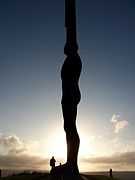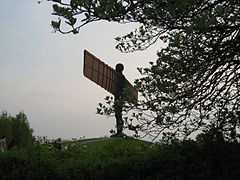Angel of the North

The Angel of the North is a contemporary sculpture, designed by Antony Gormley, which is located in Gateshead, Tyne and Wear, England.
Completed in 1998, it is a steel sculpture of an angel, 20 metres (66 ft) tall, with wings measuring 54 metres (177 ft) across.[1] The wings do not stand straight sideways, but are angled 3.5 degrees forward; Gormley did this to create "a sense of embrace".[2]
It stands on a hill on the southern edge of Low Fell, overlooking the A1 and A167 roads into Tyneside, and the East Coast Main Line rail route, south of the site of Team Colliery.[3]
Concept
According to Gormley, the significance of an angel was three-fold: first, to signify that beneath the site of its construction, coal miners worked for two centuries; second, to grasp the transition from an industrial to information age, and third, to serve as a focus for our evolving hopes and fears.[2]
Construction
Work began on the project in 1994 and cost £1 million. Most of the project funding was provided by the National Lottery. The Angel was finished on 16 February 1998.
Due to its exposed location, the sculpture was built to withstand winds of over 100 mph (160 km/h). Thus, foundations containing 600 tonnes of concrete anchor the sculpture to rock 70 feet (21 m) below. The sculpture was built at Hartlepool Steel Fabrications Ltd using Corten weather resistant steel. It was made in three parts—with the body weighing 100 tonnes and two wings weighing 50 tonnes each—then brought to its site by road. It took five hours for the body to be transported from its construction site in Hartlepool, up the A19 road to the site.[4]
The Angel aroused some controversy in British newspapers, at first, including a "Gateshead stop the statue" campaign, while local councillor Martin Callanan was especially strong in his opposition. However, it has since been considered to be a landmark for North East England[4][5] and has been listed by one organisation as an "Icon of England".[6] It has often been used in film and television to represent Tyneside, as are other local landmarks such as the Tyne Bridge and the Gateshead Millennium Bridge.
The sculpture is also known by some local people as the "Gateshead Flasher", because of its location and appearance.[7]
Maquettes
Several maquettes were produced during the development stage of the project.[8] A man-sized model from which the sculpture was created was sold at auction for £2 million in July 2008.[9] An additional bronze maquette used in fundraising in the 1990s, owned by Gateshead Council, was valued at £1 million on the BBC show Antiques Roadshow on 16 November 2008. That was the most valuable item ever appraised on the programme.[8][10] A maquette was donated to the National Gallery of Australia in 2011 and stands in its Sculpture Garden.[11]
Other projects
Inspired by the Angel of the North, several similar projects have been proposed. The 'Angel of the South' title has been given by some to the Willow Man which sits to the side of the M5 in Somerset, while a project, informally named the Angel of the South, has been proposed in Ebbsfleet, Kent. The sculpture Brick Man (also by Gormley) was proposed for the Holbeck area of Leeds.
Photo gallery
-
-
A front view of the Angel of the North
-

Detail of the Angel's body
-

Silhouette
-

-
A Lego model of Angel of the North in Miniland
-

The rear of Angel of the North (man-size maquette) at the National Gallery of Australia
See also
| Wikimedia Commons has media related to Angel of the North. |
- Angel of the West (2008)
- Angel of the South
- 'Angel of the North' statue (2009) statue by Banksy
- List of statues by height
- Wicker man
- Star of Caledonia
References
- ↑ "Facts". Gateshead.gov.uk. Retrieved 18 October 2010.
- ↑ 2.0 2.1 "The Angel of the North > Background". Gateshead Council. Archived from the original on 29 March 2007. Retrieved 9 March 2007.
Gormley said of the Angel: "... The effect of the piece is in the alertness, the awareness of space and the gesture of the wings – they are not flat, they're about 3.5 degrees forward and give a sense of embrace."
- ↑ Durham Mining Museum. "Durham Mining Museum – 1951 Durham Map 23". Dmm-gallery.org.uk. Retrieved 18 October 2010.
- ↑ 4.0 4.1 "The angel has landed". BBC. 16 February 1998. Retrieved 9 March 2007.
- ↑ "Angel of the North". AboutBritain.com. Archived from the original on 4 April 2007. Retrieved 9 March 2007.
- ↑ "Icons of England". Icons.org.uk. Retrieved 18 October 2010.
- ↑ Higgins, Charlotte (27 September 2010). "Antony Gormley". Guardian (London). Archived from the original on 30 August 2010. Retrieved 28 September 2010.
- ↑ 8.0 8.1 "Angel of the north is one in a million". Gateshead Council. 17 November 2008. Retrieved 19 November 2008.
- ↑ "The Angel of the North sold".
- ↑ "Antiques Roadshow finds £1m Angel". BBC News. 16 November 2008. Retrieved 1 January 2010.
- ↑ "Angel of the North (life-size maquette) 1996". Collection search. National Gallery of Australia. Retrieved 6 January 2013.
External links
- Gateshead Council's Angel of the North website
- Angel of the North – Antony Gormley's official website
- The Angel at icons.org, featuring pictures of the sculpture under construction
- "In praise of ... the Angel of the North". The Guardian (London). 30 January 2008. Archived from the original on 31 January 2008. Retrieved 7 February 2008.
Coordinates: 54°54′50.8″N 1°35′21.9″W / 54.914111°N 1.589417°W


